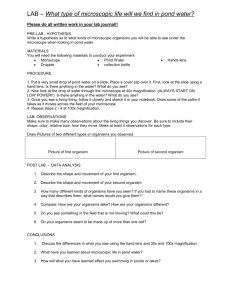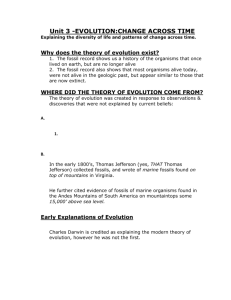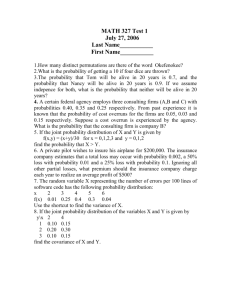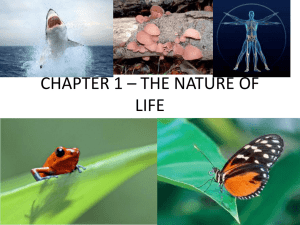The Nature of Biology
advertisement
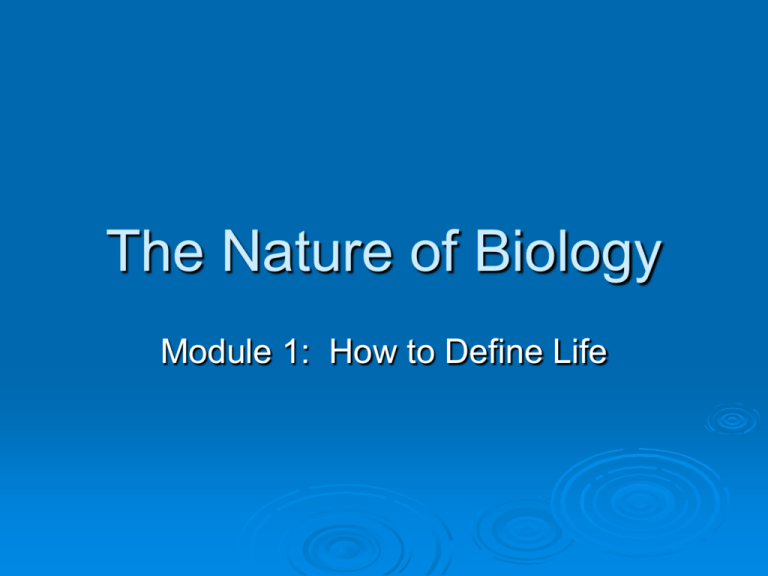
The Nature of Biology Module 1: How to Define Life How do you design an experiment? A. Problem/Purpose 1. The question the lab will answer 2. Identifies the independent and dependent variables a. Independent variable – the factor the scientist changes from group to group b. Dependent variable – the factor the scientist measures to see the effect of the independent variable Variables and Controls Videoclip How do you design an experiment? B. Research/Background Information 1. Lets the reader learn about the topic 2. Helps the scientist develop an educated hypothesis C. Hypothesis 1. An educated prediction 2. Can be tested, proven false, and agrees with previous research How do you design an experiment? D. Procedure/Experiment 1. Steps must be precise and detailed 2. Has one control group a. Normal conditions or absence of independent variable b. Used for comparison 3. Experimental group(s) have only one changing variable (which is the independent variable) How do you design an experiment? E. Observations/Data 1. Must be objective. a. Good Example: The bacterial colony is yellow. b. Bad Example: The bacterial colony is nasty. 2. Use measurements whenever possible. a. Good Example: There are 50 bacterial colonies. b. Bad Example: There are a whole bunch of colonies. How do you design an experiment? E. Observations/Data 4. Do not draw conclusions in the data section of the report. a. Good Example: There are bacteria and fungal colonies in the shoe section. b. Bad Example: The shoe was really dirty and so it was the most contaminated and grew a lot of stuff. 5. Should be organized. a. May use a graph, table, or drawing(s). b. Always include units of measurement and a title. How do you design an experiment? F. Analysis/Conclusions 1. Answers the purpose question. 2. Accepts or rejects the hypothesis. 3. Explains what can be inferred from the data. How do we know it is “good science”? A. Scientific knowledge must be shared, which allows other scientists to repeat and verify the work of others (peer review). A. Scientific knowledge is tentative. 1. Theories are the most logical explanation based on current evidence, become stronger as more evidence is gathered, and give us a basis for prediction. 2. Laws are universal generalizations that are virtually unchanging. How do you know something is alive? A. Biology means the study of (-ology) all life (bio-) and includes many branches. B. Biologists organize living things into kingdoms. There are currently six kingdoms Kingdom Example Archaebacteria Extremophile bacteria Eubacteria Typical bacteria Protista Seaweed, Amoeba, Slime Mold Fungi Yeast, Mushrooms Plantae Moss, Fern, Holly, Oak tree Animalia , Fish, Birds, Frogs, Humans How do you know something is alive? B. Characteristics of Life - Alive! Videoclip 1. Organization (The level of complexity) a. Organism Organ System Organs Tissues Cells Molecules Atoms / Elements Meet the Elements - They Might Be Giants How do you know something is alive? b. All living things need six essential elements (atoms): Carbon, Hydrogen, Nitrogen, Oxygen, Phosphorus, Sulfur (CHNOPS) c. All living things are made of cells. b. One-celled organism – unicellular c. Many-celled organism multicellular electron neutron proton How do you know something is alive? 2. Energy Use a. Organisms need energy constantly to build molecules (synthesis) and cells and to break down (digest) substances (such as breaking down food for nutrition) b. Organisms must transport nutrients to be used in cellular respiration to produce energy. c. An organisms’ chemical reactions are called its metabolism How do you know something is alive? 3. Reproduction a. Organisms must replace themselves so the entire species will survive. b. May be asexual (only one individual contributes genetic material) or sexual (two individuals contribute genes). How do you know something is alive? 4. Growth and Development a. Growth – to increase in size. Increases the number of cells of a multicellular organism. b. Development – change that takes place in structure and function of an organism during its life cycle. Example: Embryo becomes a fetus How do you know something is alive? 5. Respond to Stimuli a. A quick, nonpermanent change b. Stimulus – any condition that causes an organism to react. Example – A loud noise (stimulus) causes your dog to run under the bed (response). How do you know something is alive? 6. Adjust to Environment a.Homeostasis - the regulation of an organism’s internal environment to maintain conditions suitable for life Ex: Getting rid of wastes by excretion How do you know something is alive? b. An adaptation is an inherited structure, behavior, or internal process that enables organisms to better survive an environment. Ex: Gills on a fish Life Processes: STERNGRR Synthesis – making materials Transport – moving materials Excretion – getting rid of wastes Respiration – gas exchange AND production of energy (ATP) Nutrition – gaining and using energy from food Growth and Development – getting bigger and/or changing Regulation – controlling internal processes Reproduction – producing new cells or new organisms What technology allows biologists to study microscopic life? A. Compound Light Microscope 1. Has two lenses – ocular (eyepiece) and objective 2. In order to be viewed, specimen must be thin (so the light may shine through the specimen) and placed on a slide. 3. Specimen may be stained to better see structures What technology allows biologists to study microscopic life? B. Electron Microscope 1. 2. Eye of an ant Uses electrons to produce an image Types: a. Scanning Electron Microscope (SEM) i. Sends a beam of electrons across the object’s surface ii. Produces a 3-D image b. Transmission Electron Microscope (TEM) i. Designed to look at structures inside a cell ii. Capable of greatest magnification What technology allows biologists to study microscopic life? C. Limitations of microscopes 1. Magnification is limited by the strength of the lens. a. Calculating magnification: Ocular lens x objective lens = total magnification b. Example: Ocular (10x) x objective (40x) = 400x 2. As magnification increases resolution/(sharpness) decreases.

